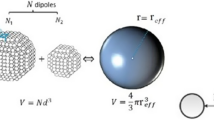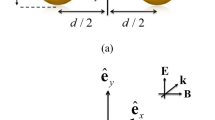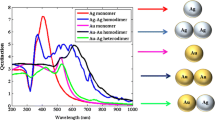Abstract
In the present work, an investigation of wavelength-dependent absorption spectrum of spherical nanoparticles with different arrangements in organic medium using discrete dipole approximation (DDA) has been performed. Specifically, we study the impact of different arrangements such as monomer, dimer (compositionally symmetric and asymmetric), 1D array of spherical nanoparticle on surface plasmon resonance (SPR) peak position, and its spectral broadening in distinct regimes of the electromagnetic spectrum. Three different organic materials such as P3HT:PCBM blend (Poly(3-hexyl thiophene))-(phenyl-C61-buryricacid methyl ester), P3HT(poly (3-hexyl thiophene)), and PEOPT ((4’-(1”, 4”, 7”-trioaoctyl) phenyl) theophany) have been chosen in the present work to study the absorption and scattering spectrum of MNP. Further, near-field pattern of homo-dimer nanogeometry is also shown in the present study. We also observed that on increasing the interacting number of particles in 1D array, the corresponding FWHM (full width at half maxima) value increases as well, which covers the large spectral region of the electromagnetic spectrum. The comparison between dipole model and numerical model has been performed to analyze the extinction behavior of smaller size (d << λ) metal nano dimer which shows a good agreement in 400–600nm wavelength range.












Similar content being viewed by others
References
Green M (2004) Recent developments in photovoltaics. Solar energy 76(1):3
Catchpole K, Polman A (2008) Plasmonic solar cells. Optics express 16(26):21793
Hoppea H, Sariciftci NS (2004) Organic solar cells: an overview. J Mater Res 19(7):1925
Green MA Third generation photovoltaics. (Springer, 2006)
Catchpole KR, McCann MJ, Weber KJ, Blakers AW (2001) A review of thin-film crystalline silicon for solar cell applications. Part 2: Foreign substrates. Sol Energy Mater Sol Cells 68(2):173
Shrotriya V, Li G, Yao Y, Chu CW, Yang Y (2006) Transition metal oxides as the buffer layer for polymer photovoltaic cells. Appl Phys Lett 88(7):073508
Koynov S, Brandt MS, Stutzmann M (2006) Black nonreflecting silicon surfaces for solar cells. Appl Phys Lett 88(20):203107
Ashkin A, Dziedzic J, Bjorkholm J, Chu S (1986) Observation of a single-beam gradient force optical trap for dielectric particles. Opt Lett 11(5):288
Konishi K, Sugimoto T, Bai B, Svirko Y, Kuwata-Gonokami M (2007) Effect of surface plasmon resonance on the optical activity of chiral metal nanogratings. Opt Express 15(15):9575
Kim JY, Lee K, Coates NE, Moses D, Nguyen TQ, Dante M, Heeger AJ (2007) Efficient tandem polymer solar cells fabricated by all-solution processing. Science 317(5835):222
Angermann H (2008) Passivation of structured p-type silicon interfaces: effect of surface morphology and wet-chemical pre-treatment. Appl Surf Sci 254(24):8067
Green MA, Pillai S (2012) Harnessing plasmonics for solar cells. Nat Photonics 6(3):130
Li X, Choy WC, Huo L, Xie F, Sha WE, Ding B, Guo X, Li Y, Hou J, You J et al (2012) Dual plasmonic nanostructures for high performance inverted organic solar cells. Adv Mater 24(22):3046
Na SI, Oh SH, Kim SS, Kim DY (2009) Efficient organic solar cells with polyfluorene derivatives as a cathode interfacial layer. Org Electron 10(3):496
Chandrasekhar N, Basak S, Mohiddon MA, Chandrasekar R (2014) Planar active organic waveguide and wavelength filter: self-assembled meso-tetratolylporphyrin hexagonal nanosheet. ACS Appl Mater Interfaces 6 (3):1488
Sahu P (2016) Theoretical investigation of all optical switch based on compact surface plasmonic two mode interference coupler. J Light Technol 34(4):1300
Lindquist NC, Luhman WA, Oh SH, Holmes RJ (2008) Plasmonic nanocavity arrays for enhanced efficiency in organic photovoltaic cells. Appl Phys Lett 93(12):123308
Dang MT, Hirsch L, Wantz G (2011) P3HT: PCBM, best seller in polymer photovoltaic research. Adv Mater 23(31):3597
Kerp H, Donker H, Koehorst R, Schaafsma T, Van Faassen E (1998) Exciton transport in organic dye layers for photovoltaic applications. Chem Phys Lett 298(4):302
Peumans P, Yakimov A, Forrest SR (2003) Small molecular weight organic thin-film photodetectors and solar cells. J Appl Phys 93(7):3693
Yu G, Gao J, Hummelen JC, Wudl F, Heeger AJ (1995) Polymer photovoltiac cells: enhanced efficiencies via a network of internal donor-acceptor heterojunctions. Science 270(5243):1789
Duche D, Torchio P, Escoubas L, Monestier F, Simon JJ, Flory F, Mathian G (2009) Improving light absorption in organic solar cells by plasmonic contribution. Sol Energy Mater Sol Cells 93(8):1377
Xue M, Li L, Tremolet de Villers BJ, Shen H, Zhu J, Yu Z, Stieg AZ, Pei Q, Schwartz BJ, Wang KL (2011) Charge-carrier dynamics in hybrid plasmonic organic solar cells with Ag nanoparticles. Appl Phys Lett 98(25):119
Westphalen M, Kreibig U, Rostalski J, Lüth H, Meissner D (2000) Metal cluster enhanced organic solar cells. Sol Energy Mater Sol Cells 61(1):97
Zhu SQ, Zhang T, Guo XL, Shan F, Zhang XY (2014) Light absorption enhancement in organic solar cell by embedding Ag nanoparticles and nanochains within the active layer. J Nanomater 2014:45
Kang MG, Xu T, Park HJ, Luo X, Guo LJ (2010) Efficiency enhancement of organic solar cells using transparent plasmonic Ag nanowire electrodes. Adv Mater 22(39):4378
Kim SS, Na SI, Jo J, Kim DY, Nah YC (2008) Plasmon enhanced performance of organic solar cells using electrodeposited Ag nanoparticles. Appl Phys Lett 93(7):305
Sharma R, Roopak S, kumar Pathak N, Sharma R et al (2016) Plasmonics pp 1–10
Sharma R, Roopak S, kumar Pathak N, Uma R, Sharma R (2017) Plasmonics, pp 1–9
Shen H, Bienstman P, Maes B (2009) Plasmonic absorption enhancement in organic solar cells with thin active layers. J Appl Phys 106(7):073109
Lakowicz JR (2006) Plasmonics in biology and plasmon-controlled fluorescence. Plasmonics 1(1):5
Ghosh SK, Pal T (2007) Interparticle coupling effect on the surface plasmon resonance of gold nanoparticles: from theory to applications. Chem Rev 107(11):4797
Ando M, Kawasaki M, Imazeki S, Sasaki H, Kamata T (2004) Self-aligned self-assembly process for fabricating organic thin-film transistors. Appl Phys Lett 85(10):1849
Maity S, Bhunia C, Sahu P (2016) Improvement in optical and structural properties of ZnO thin film through hexagonal nano- pillar formation to improve the efficiency of a Si–ZnO heterojunction solar cell. J Phys D Appl Phys 49(20):205104
Maity S, Bhunia CT, Sahu P (2014) Improvement of some effective parameters of C-SI solar cell for better efficiency. Acta Technica Napocensis 55(3):4
Pathak NK, Ji A, Sharma R (2014) Study of efficiency enhancement in layered geometry of excitonic-plasmonic solar cell. Appl Phys A 115(4):1445
Maier SA (2007) Plasmonics: fundamentals and applications. Springer Science & Business Media, Berlin
Draine BT, Flatau PJ (2012) ArXiv e-prints
Draine BT, Flatau PJ (1994) Discrete-dipole approximation for scattering calculations. J Opt Soc Am A 11(4):1491
Barth J, Johnson R, Cardona M, Palik E (1991) Handbook of optical constants of solids II. Academic Press, New York
Johnson PB, Christy RW (1972) Optical constants of the noble metals. Phys Rev B 6(12):4370
Van Dijk M, Tchebotareva A, Orrit M, Lippitz M, Berciaud S, Lasne D, Cognet L, Lounis B (2006) Absorption and scattering microscopy of single metal nanoparticles. Phys Chem Chem Phys 8(30):3486
Lee JY, Peumans P (2010) The origin of enhanced optical absorption in solar cells with metal nanoparticles embedded in the active layer. Opt Express 18(10):10078
Chang YC, Wang SM, Chung HC, Tseng CB, Chang SH (2012) Observation of absorption-dominated bonding dark plasmon mode from metal–insulator–metal nanodisk arrays fabricated by nanospherical-lens lithography. Acs Nano 6(4):3390
Roopak S, kumar Pathak N, Sharma R, Ji A, Pathak H, Sharma R (2016) Numerical simulation of extinction spectra of plasmonically coupled nanospheres using discrete dipole approximation: influence of compositional asymmetry. Plasmonics 11 (6): 1603
Gérard D, Gray SK (2014) Aluminium plasmonics. J Phys D Appl Phys 48(18):184001
Author information
Authors and Affiliations
Corresponding author
Rights and permissions
About this article
Cite this article
Sharma, R., Pathak, N.K. & Sharma, R.P. Computational Study of Plasmon Interaction in Organic Media: a Comparison Between Analytical and Numerical Model for Dimer. Plasmonics 13, 1775–1784 (2018). https://doi.org/10.1007/s11468-018-0691-9
Received:
Accepted:
Published:
Issue Date:
DOI: https://doi.org/10.1007/s11468-018-0691-9




